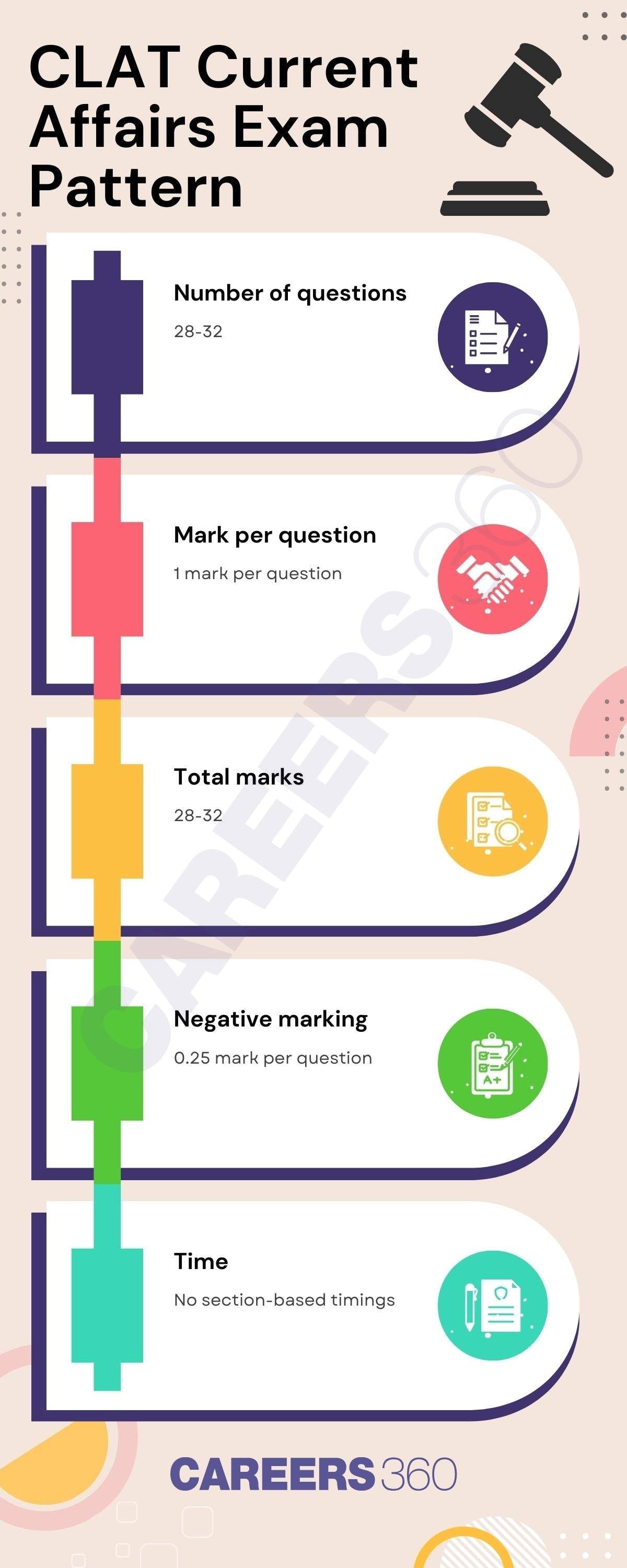Amity University-Noida Law Admissions 2026
Among top 100 Universities Globally in the Times Higher Education (THE) Interdisciplinary Science Rankings 2026
CLAT GK Syllabus 2026: The Consortium of NLUs prescribes the CLAT GK 2026 syllabus on its official website - consoritumofnlus.ac.in. The syllabus of CLAT GK 2026 tests the candidate’s awareness about current affairs and updates about the latest developments in various fields. The current affairs and GK section will contain passages up to 450 words derived from news articles, journalistic sources and other non-fiction writings. The CLAT current affairs syllabus 2026 also tests the candidate’s knowledge about law with the information given in the passage. This section also evaluates a candidate's general awareness and ability to connect issues contextually, which is important for legal reasoning and analysis. Read the complete article to get details on CLAT GK syllabus 2026 including topics, sample papers, and preparation tips.
This Story also Contains

The CLAT current affairs including general knowledge section carries 25% weightage in the Common Law Admission Test. Candidates should formulate an effective preparation strategy, as there will be 28-32 questions from the CLAT GK syllabus 2026 in the question paper. CLAT 2026 will be conducted on December 7, 2025.
| Particulars | Particulars |
|---|---|
Types of questions | MCQs based on passages |
Weightage in CLAT 2026 syllabus | 25% |
Number of questions | 28-32 |
Skills tested | Awareness about current affairs and legal knowledge |
You may also check - CLAT GK Questions with Answer PDF
The GK section forms 25% of the overall CLAT syllabus, which makes the section very important. The CLAT current affairs syllabus 2026 consists of 4-6 passages of around 450 words, which are followed by multiple-choice questions based on the passage. The passages will be drawn from journalistic and non-fiction sources. Each passage will be followed by 4-6 questions. Candidates have to answer the questions based on the information given in the passage.
The syllabus of CLAT 2026 GK is a test of the candidate’s awareness about the latest happenings in different fields. Some of the questions in the CLAT 2026 current affairs syllabus will also test the candidate’s legal knowledge. However, such questions can be answered based on the information given in the passage
| Topics | |
|---|---|
National and international events | Politics |
Sports | Science and Technology |
Arts and Culture | Historical events with current relevance |
Awards and achievements | Important personalities |
Business and economy | Legal knowledge |
Check Popular Law Courses:
| Cyber Law | Criminal Law |
| Environmental Law | Family Law |
| IP and Technology Law | Company Law |
| Labour Law | Immigration Law |
| Taxation Law | Insurance Law |
Among top 100 Universities Globally in the Times Higher Education (THE) Interdisciplinary Science Rankings 2026
Ranked #18 amongst Institutions in India by NIRF | Ranked #1 in India for Academic Reputation by QS Rankings | 16 LPA Highest CTC
The CLAT 2026 GK section will test the following abilities in the candidate:
Reading and comprehension ability
Awareness about the latest socio-political and economic developments in India and around the world.
Candidate’s legal knowledge
Ability to draw logical inferences and conclusions
| Particulars | Details |
|---|---|
Number of questions | 28-32 |
Mark per question | 1 mark per question |
Total marks | 28-32 |
Negative marking | 0.25 mark per question |
Time | No section-based timings |

The static GK is also an important part of the CLAT GK 2026 syllabus. There will be questions on static general knowledge in the CLAT GK section if the issue has some contemporary relevance. The static questions which do not have current relevance will usually not find a place in the CLAT current affairs syllabus.
You may also check -
The syllabus of current affairs for CLAT 2026 tests the candidate’s general awareness about different fields. Any questions of legal current affairs in the GK section will be limited to the information given in the passage. Given below are a few preparation tips for the CLAT GK that law aspirants can refer to.
Develop a regular reading habit of newspapers and magazines to stay abreast with the latest developments in the national and international arena.
Regularly read law magazines, which will improve legal awareness and legal reasoning to quickly answer legal knowledge questions in the CLAT current affairs syllabus.
Practise memory-enhancing techniques such as mnemonics and association making to retain the knowledge, especially static GK.
Practise with CLAT 2026 sample papers to improve speed and assess the level of one’s preparation.
The table given below provides a list of books for CLAT 2026 current affairs and learning resources.
List of CLAT GK Books | |
|---|---|
Lucent’s General Knowledge | Manorama Year Book |
Competition Success Review | Pratiyogita Darpan |
Newspapers such as The Hindu and The Times of India | India Year Book |
| The Hindu Newspaper | Pearson General Knowledge Manual |
An important part of one’s preparation is to refer to the sample papers of Current Affairs for CLAT 2026. Given below is the link to download the official CLAT question papers from previous years. Click on the link to download the CLAT GK sample papers for free.
Particulars | Details |
|---|---|
CLAT previous year question paper |
Frequently Asked Questions (FAQs)
The syllabus of CLAT GK covers a wide range of topics. Candidates must devote a good amount of time to reading up on the latest updates and retaining the knowledge.
CLAT current affairs syllabus 2026 will have questions from the recent national and international events as well as static GK.
The GK syllabus in CLAT consists of various sections like Politics, Geography, Science and technology, General Science, Industries, Agriculture and more.
The CLAT GK syllabus is typically of moderate to high difficulty level. The CLAT GK paper is compulsory for all aspirants.
On Question asked by student community
Hello aspirant,
The Gujarat domicile rank is useful only for seats reserved under the domicile quota at GNLU Gandhinagar. However, even for domicile candidates, GNLU cutoffs usually close at much better All India Ranks. With an AIR of 19000, the chances are quite low, but since counselling invitation is received, it is still worth participating as some movement can happen in later rounds. Do not rely only on domicile rank final allotment depends on AIR, category and seat availability.
FOR REFERENCE : https://law.careers360.com/articles/gnlu-gandhinagar-admission
Hope the details will help you.
THANK YOU
Hello,
Based on previous year CLAT cutoff trends , your chances for NLSIU Bangalore are very low .
NLSIU Bangalore has the highest cutoff among all NLUs . In recent years, the final closing rank for General category has been around AIR 100–120 only.
You have:
General category AIR: 658
Women category rank: 313
No Karnataka domicile
Women reservation in NLUs is horizontal , not a separate quota. This means it does not add extra seats . It only helps when candidates are very close to the general cutoff. At a rank of 313 , the gap is too large.
Even in spot or final rounds, NLSIU does not go beyond ~120 rank for General category candidates without domicile.
However, with these ranks, you have good chances in other top NLUs like NALSAR Hyderabad, WBNUJS Kolkata, NLU Jodhpur, GNLU Gandhinagar, and NLIU Bhopal, depending on counselling rounds.
You can also use our CLAT College Predictor Tool to predict which colleges you can get based on your score and rank.
Hope it helps !
Good afternoon,
With 86.7 marks and 1906 rank in CLAT 2026, you have a chance to get admission in mid-tier and the newest NLUs. The list of probable NLUs where you can get admission is mentioned below.
1. RMLNLU Lucknow
2. MNLU Mumbai
3. DSNLU Visakhapatnam
4. NLU Odisha
5. CNLU Patna
Thank you.
Hello,
Yes, a student with CLAT 2026 rank around 12,000 can register for counselling.
However, chances of getting a seat in the top NLUs (like NLSIU Bangalore, NALSAR Hyderabad, WBNUJS Kolkata, NLIU Bhopal) are very low, as their closing ranks are usually below 4,000 for the general category.
For mid-tier NLUs (like NLU Jodhpur, HNLU Raipur, GNLU Gandhinagar, RMLNLU Lucknow), closing ranks generally go up to 5,000–8,000, so it will still be difficult.
Lower-tier NLUs (like NLU Odisha, NUALS Kochi, NUSRL Ranchi, NLUJA Assam, DSNLU Vizag, TNNLU, HPNLU Shimla) sometimes admit candidates with ranks in the 10,000–30,000 range , especially in later counselling rounds or if there are vacancies. State quota reservations can also improve chances.
You can also use our CLAT College Predictor Tool to predict which colleges you can get based on your score and rank.
Hope it helps !
Hello,
A CLAT score of 81.25 places you in the moderate range, where admission to top NLUs becomes difficult, but opportunities may still remain in newer and mid-tier NLUs, depending on your category, seat movement, and round wise cutoffs.
https://law.careers360.com/articles/clat-2026-college-predictor
Hope you understand.
Among top 100 Universities Globally in the Times Higher Education (THE) Interdisciplinary Science Rankings 2026
Ranked #18 amongst Institutions in India by NIRF | Ranked #1 in India for Academic Reputation by QS Rankings | 16 LPA Highest CTC
AICTE & UGC Approved | NAAC A+ Accredited
NAAC A++ Approved | Curriculum Aligned with BCI & UGC
India's Largest University | BCI approved | Meritorious Scholarships up to 5 lacs |
Integrated Learning – A balanced blend of management and legal education